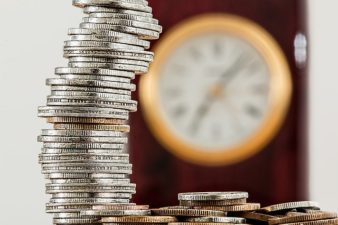Who isn’t aiming for a carefree retirement? You can plan for one by building an investment portfolio, which will generate the income you need. Here, we’ll focus on stocks, so the returns will come from dividends or price appreciation.
How much do you need to invest every year? And how much growth is needed from your portfolio?
How much you can save and invest depends on your situation and your diligence in saving. Here, we’ll use a fictional character, Bill, as an example. He earns the median income of $36,000 and uses up 90% of his earnings (i.e., $32,400) for his cost of living and taxes and is able to invest $3,600 each year.
(According to Statistics Canada, the median income earned by an individual was $33,920 in 2015. Assuming a 3% inflation rate, the median income would be roughly $36,000 this year.)
Since income from dividends can be set up to be more reliable than returns from price gains, Bill decided to build a portfolio with a focus on income generation and the growth of that income.
If Bill saves and invests $3,600 per year (or $300 per month) and gets a 3.5% yield from his portfolio, how long does it take him to generate $33,920 of income? He calculates that he needs a portfolio of $969,143 with a 3.5% yield to generate an income of $33,920 per year. Using an online tool that calculates compound returns, Bill finds out that he will amass $1,047,302 by year 40 if his portfolio will grow 8% per year.

Which stocks can generate an 8% rate of return?
As much as possible, Bill wants to stabilize the returns with dependable, growing dividends. He has identified two such stocks to start his portfolio.
Royal Bank of Canada (TSX:RY)(NYSE:RY) is the leader among the Canadian banks and has generated high returns on equity of at least 12% in the last decade. At ~$98.50, the bank offers a yield of ~3.7% and trades at a multiple of ~13.2, which is a valuation that’s within reason.
The bank is estimated to grow its earnings per share by 6-7% per year. Using the lower end of that growth rate, the stock can deliver long-term returns of nearly 10%. So, it gives some margin of error for the 8% rate of return that Bill needs.
He also invests in Altagas Ltd. (TSX:ALA) because of its nearly 7.5% yield, which is supported by cash flow generated from its diversified business consisting of utility, power-generation, and midstream assets. Essentially, the investment only needs to grow 0.5% for Bill to hit his target, which is a low step to overcome.
Investor takeaway
The magical thing about building a diversified portfolio of stable dividend-growth stocks is that if Bill aims for that $33,920 of dividend generation for income, the stocks will take care of inflation.
For instance, Royal Bank and Altagas’s three-year dividend-growth rates were 8.6% and 10.6%, respectively. Going forward, they should be able to increase their dividends by at least 5% per year.
Some more thoughts
Bill hasn’t taken into account other sources of income during his retirement, such as the Canadian Pension Plan and the Old Age Security pension. He also hasn’t accounted for raises and bonuses he might get that could allow him to increase his savings rate and reduce the number of years to reach his goal.
Before investing though, Bill should have at least three to six months of cost of living money saved up as an emergency fund. The example uses a simplified model — assuming a smoothed-out rate of return of 8%. However, in the real world, the net value of the portfolio can be quite volatile: up 15% one year and down 8% the next.









